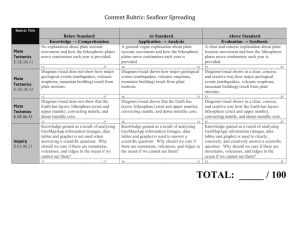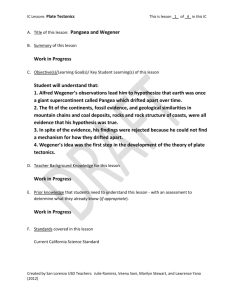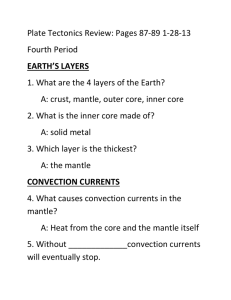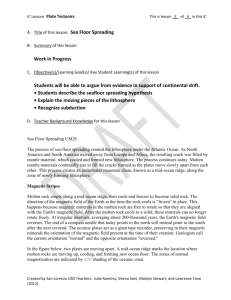Work in Progress
advertisement
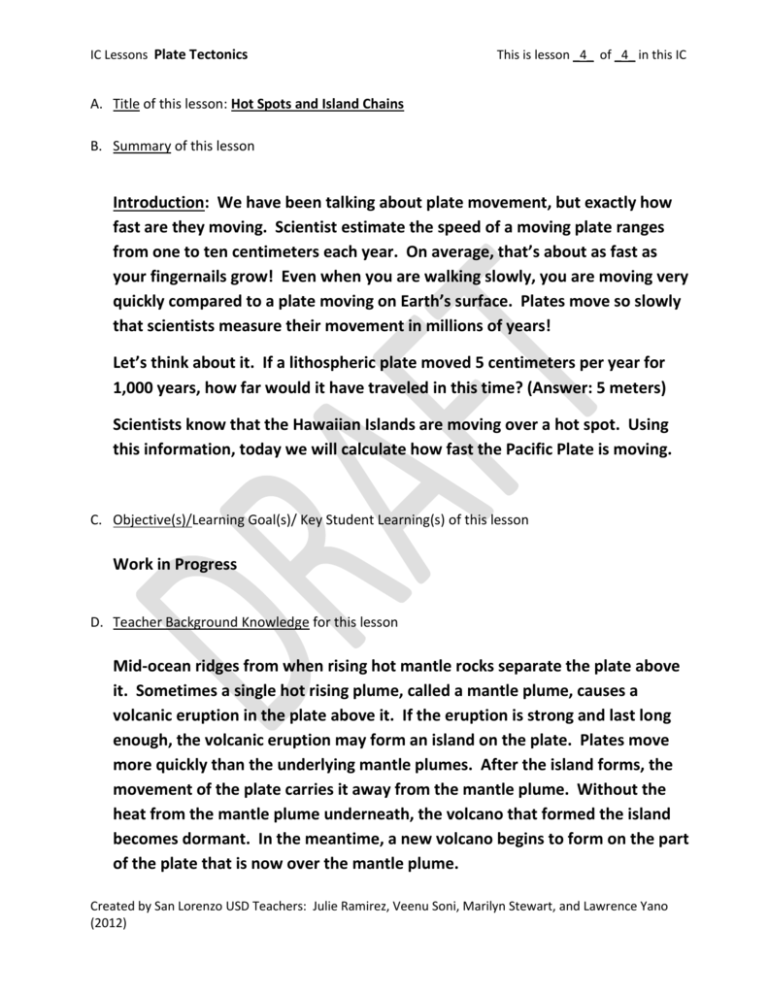
IC Lessons Plate Tectonics This is lesson _4_ of _4_ in this IC A. Title of this lesson: Hot Spots and Island Chains B. Summary of this lesson Introduction: We have been talking about plate movement, but exactly how fast are they moving. Scientist estimate the speed of a moving plate ranges from one to ten centimeters each year. On average, that’s about as fast as your fingernails grow! Even when you are walking slowly, you are moving very quickly compared to a plate moving on Earth’s surface. Plates move so slowly that scientists measure their movement in millions of years! Let’s think about it. If a lithospheric plate moved 5 centimeters per year for 1,000 years, how far would it have traveled in this time? (Answer: 5 meters) Scientists know that the Hawaiian Islands are moving over a hot spot. Using this information, today we will calculate how fast the Pacific Plate is moving. C. Objective(s)/Learning Goal(s)/ Key Student Learning(s) of this lesson Work in Progress D. Teacher Background Knowledge for this lesson Mid-ocean ridges from when rising hot mantle rocks separate the plate above it. Sometimes a single hot rising plume, called a mantle plume, causes a volcanic eruption in the plate above it. If the eruption is strong and last long enough, the volcanic eruption may form an island on the plate. Plates move more quickly than the underlying mantle plumes. After the island forms, the movement of the plate carries it away from the mantle plume. Without the heat from the mantle plume underneath, the volcano that formed the island becomes dormant. In the meantime, a new volcano begins to form on the part of the plate that is now over the mantle plume. Created by San Lorenzo USD Teachers: Julie Ramirez, Veenu Soni, Marilyn Stewart, and Lawrence Yano (2012) IC Lessons Plate Tectonics This is lesson _4_ of _4_ in this IC This process repeats over and over again and forms a string of islands. The first island formed in the string is made of old dormant volcanoes, while the most recent island the string probably has active volcanoes. Scientists determine the direction and speed of plate movement by measuring these island chains. The Hawaiian Islands are a good example of an island chain formed by a mantle plume hot spot. We can use the activity “How Fast Does a Plate Move” as a math activity to figure out the speed of movement. E. Prior knowledge that students need to understand this lesson - with an assessment to determine what they already know (if appropriate). Work in Progress F. Standards covered in this lesson Current California Science Standards NGSS Work in Progress CCSS that apply Reading: Work in Progress Writing: Work in Progress Listening & Speaking: Work in Progress Math: Work in Progress G. Suggested time to complete this lesson Work in Progress Created by San Lorenzo USD Teachers: Julie Ramirez, Veenu Soni, Marilyn Stewart, and Lawrence Yano (2012) IC Lessons Plate Tectonics This is lesson _4_ of _4_ in this IC H. Materials Used in this lesson typed in a bulleted list with quantities (e.g., 10 beakers; water – 2 liters) Work in Progress I. Materials Prep for this lesson Work in Progress J. Lesson Plan – detailed, numbered step-by-step plans. Work in Progress K. Vocabulary words – key vocabulary words that are targeted or taught as part of the lesson. (Understanding these words is essential for students to understand the key concepts of this lesson.) Work in Progress L. Potential Pitfalls for: a. student understanding; b. laboratory mishaps and common procedural errors; c. academic vocabulary issues, etc. Work in Progress M.Differentiation: Modifications for English Learners, advanced learners, struggling learners, etc. Work in Progress N. Please list all worksheets used in this lesson. How fast is Pacific plate moving activity.pdf Created by San Lorenzo USD Teachers: Julie Ramirez, Veenu Soni, Marilyn Stewart, and Lawrence Yano (2012) IC Lessons Plate Tectonics This is lesson _4_ of _4_ in this IC O. Please list all assessments that require a separate sheet. Work in Progress P. Photos/Illustrations Work in Progress Q. Other Resources Work in Progress Created by San Lorenzo USD Teachers: Julie Ramirez, Veenu Soni, Marilyn Stewart, and Lawrence Yano (2012)



